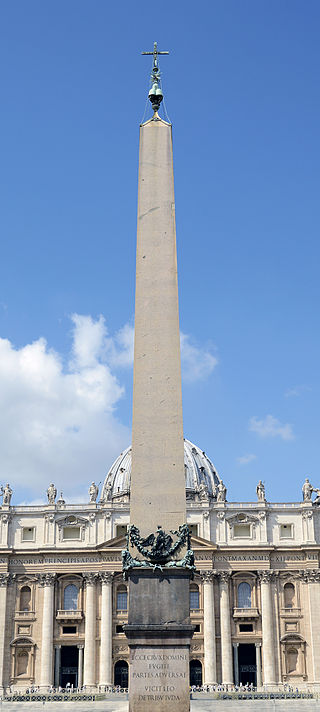Top Qs
Timeline
Chat
Perspective
Vatican obelisk
Egyptian obelisk in St. Peter's Square, Vatican City From Wikipedia, the free encyclopedia
Remove ads
The Vatican Obelisk is an Egyptian obelisk, one of the thirteen ancient obelisks of Rome. This obelisk is located in St. Peter's Square, in Vatican City. It is the only ancient obelisk in Rome that has never fallen.[1][2]

Made of red granite, it has a height of 25.3 meters and, together with the cross and the base (composed of four bronze lions, by Prospero Antichi), it reaches almost 40 meters.
It is of Egyptian origin, devoid of any hieroglyphs and titles. It is not known if the obelisk's inscriptions were erased before it was moved to Rome, or if it never had any. The obelisk comes, according to Pliny,[3] from the city of Heliopolis on the Nile. Before coming to Rome, it stood at the Forum Iulii of Alexandria in Egypt. Emperor Caligula had it shipped to Rome in 40 AD, and placed it at the center of the Circus of Nero, the site of which is, in modern times, mostly in Vatican City. It remained in this position after the circus fell into disuse, occupied by a necropolis. In the 16th century it was moved next to the Old St. Peter's Basilica, at the Rotonda di Sant'Andrea.
Remove ads
History
Summarize
Perspective

Having stood in the same location in Rome since c.40 AD, it was moved almost 800 feet at the behest of Pope Sixtus V in a single day on September 10, 1586.[1] The work was carried out under the direction of the architect Domenico Fontana who required thirteen months of preparatory work, 800 men, 160 horses and 45 winches to carry out the work. It was the first of Rome's obelisks to be raised in modern times. In the uplift operations there was a famous cry of a certain sailor Benedetto Bresca: Acqua alle funi ("Water on the ropes!"), in order to avoid the breakage of the ropes that were about to give in under the great weight of the obelisk.
The idea of moving the obelisk was first raised by Pope Nicholas V.[4] Sixtus V's relocation was considered to be a symbolic act, illustrating the triumph of Christianity over Paganism. Following the successful relocation, Fontana was commissioned to move three smaller obelisks in Rome.[5]
A detailed account of the relocation was published in Della transportatione dell'obelisco Vaticano e delle fabriche di Sisto V (Rome, 1590).[6][7] The astronomer Ignazio Danti is known to have assisted Fontana in this work.
According to a popular medieval legend, the ancient bronze globe that crowned the obelisk was believed to contain the ashes of Julius Caesar or Trajan. On the occasion of the obelisk's relocation, the globe was presented to the city by Sixtus V. It was placed first on the Marforio fountain, then in 1692 on the balustrade of the Piazza del Campidoglio. In 1848 it was brought into the Palazzo dei Conservatori.[8]
The granting of a perpetual indulgence of ten years and as many quarantines to those who, in front of the obelisk, venerate the cross of Christ by reciting Lord's Prayer and Hail Mary, made it assumed that Sixtus V had placed in the great bronze cross placed on the obelisk a particle of the True Cross on September 26, 1586, albeit during a later restoration of the cross, no relic was found.[citation needed]
Remove ads
Inscriptions
Summarize
Perspective
The obelisk and its base contain a number of inscriptions. Two ancient inscriptions at the base of the shaft describe its original dedication in Rome, four inscriptions on the pedestal composed by Cardinal Silvio Antoniano describe its rededication in 1586, and lower down, in smaller script, is an acknowledgement of Domenico Fontana's role in the moving of the obelisk.
Remove ads
Gallery
- The obelisk in the Circus of Nero Maarten van Heemskerck, 1532
- Mural (1585–1588) in the Vatican Library of the re-erection in St. Peter's Square
- Bronze globe and spike from the top of the obelisk, now in the Capitoline Museums
- One possible modern interpretation[9]
References
Bibliography
Wikiwand - on
Seamless Wikipedia browsing. On steroids.
Remove ads




